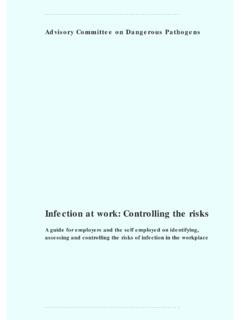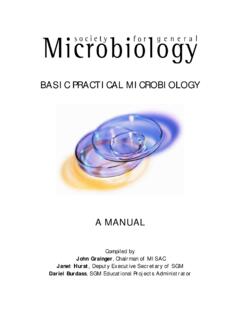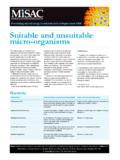Transcription of Protection against blood-borne infections in the workplace ...
1 advisory Committee on dangerous pathogens Protection against blood-borne infections in the workplace : HIV and Hepatitis Introduction to this guidance Overview 1 2 People suffering from certain infections may have the agent of disease present in their blood. In some cases the organisms persist in the blood for long periods and in sufficient numbers to represent a high risk of transmission. If others are exposed to their blood - or other bodily fluids - the infectious agent may be transferred into their bodies and infect them.
2 The main risk of occupationally acquired blood borne infection relates to viruses that persist in the blood and are known to be endemic in the UK population. In these cases, the infectious agent is usually a blood-borne virus (BBV). The individual infected with the virus may not show symptoms or even be aware that they are carrying it. Info Box : Bodily fluids that may contain BBVs Blood Cerebrospinal fluid Pleural fluid Breast milk Amniotic fluid Vaginal secretions Peritoneal fluid Pericardial fluid Synovial fluid Semen Other bodily fluids containing blood Urine, faeces, saliva, sputum, tears, sweat and vomit, present a minimal risk of blood-borne virus infection unless they are contaminated with blood.
3 However, they may be hazardous for other reasons. 3 4 BBVs of major concern are the human immunodeficiency virus (HIV, which causes Acquired Immune Deficiency Syndrome or AIDS), and Hepatitis B and C, which may result in chronic infection. These viruses represent a significant risk of blood-borne transmission. This guidance will therefore concentrate only on these viruses. Purpose of the guidance The aim of this guidance is to offer assistance to a wide readership, including those with responsibility for Health and Safety, as well as those in Occupational Health disciplines that need to assess the risks associated with exposure to such viruses.
4 It is intended to cover any workplace situation where exposure to blood-borne viruses (BBV) is possible. Controls that minimise risks during exposure-prone procedures, and recommended actions in the event of an exposure, are presented. In addition to providing information on a wide range of BBV related topics (see below), signpost information is also used throughout this guidance, in the form of hyperlinks and footnotes, to take the reader to other, often specialised documents produced by others.
5 5 This guidance is divided into four main parts: Part 1: Background information 4 This section provides background information on blood-borne viruses that are relevant to various UK occupational settings. This technical information may be particularly useful to those with an existing insight in to viral infection, but who may wish to learn more about the process of transmission and disease Part 2: Health and safety law 18 This section concerns relevant health and safety law and the legal duties of employers with respect to hazard and risk assessment.
6 This includes consideration of emergency planning, staff training, control measures and health surveillance Part 3: Control measures against blood-borne infections 32 This section covers the practical process of risk assessment, and gives guidance on control measures that can mitigate the risk of infection in occupational situations. Other working environments are also considered, since exposure prone activities and professional care of BBV-infected individuals may take place outside of the clinical setting Part 4: Guidance on management of incidents potentially involving exposure to a blood-borne virus 53 This section provides guidance on what should be done in situations where a significant exposure to BBV has occurred.
7 This section also offers fundamental information on risk assessment related to post exposure prophylaxis (PEP), with signposts to specialist information sources, as appropriate. Appendices are also provided to cover certain areas in more detail. These include: Appendix 1 - Use of gloves 59 This appendix gives more detailed advice on the use of gloves as personal protective equipment and includes considerations relating to what gloves are appropriate to certain work activities and how to remove gloves safely in order to prevent cross-contamination Appendix 2 Transport of infectious substances 63 This appendix provides an overview of the transport requirements for materials containing or contaminated with blood borne viruses Appendix 3
8 Sector-specific practical guidance 66 This appendix provides an overview of Blood Borne Virus-related guidance relating to a variety of work place activities and relevant links to other specialist sites that serve specific work sectors Appendix 4 General contact details not previously mentioned in other sections 80 Terminology 6 7 8 9 10 The term blood-borne virus (BBV) will be used in this guidance for brevity. Whenever this term is used, or blood is otherwise mentioned, it should be taken to include any high-risk body fluid (Info box ) unless stated otherwise.
9 The BBV covered in this guidance are pathogens capable of causing severe disease and even death. Whilst medical treatments ( post-exposure prophylaxis) may be available and effective, a common high standard of handling should be applied in all contact with blood, body fluids and tissues. Other blood-borne infections exist that are not covered by this guidance. The control measures recommended are applicable to the majority of other infectious agents that may be found in blood at some time during the course of an illness.
10 Preparation of the guidance The advisory Committee on dangerous pathogens (ACDP) has prepared this guidance in consultation with HSE. ACDP advises the Health and Safety Executive, Health Protection Agency, Health and Agriculture Ministers and their counterparts under devolution in Scotland, Wales and Northern Ireland, as required, on all aspects of hazards and risks to workers and others from exposure to pathogens . The guidance represents what is considered to be good practice by the members of the ACDP and has been agreed by the Health and Safety Commission and Health Ministers.













